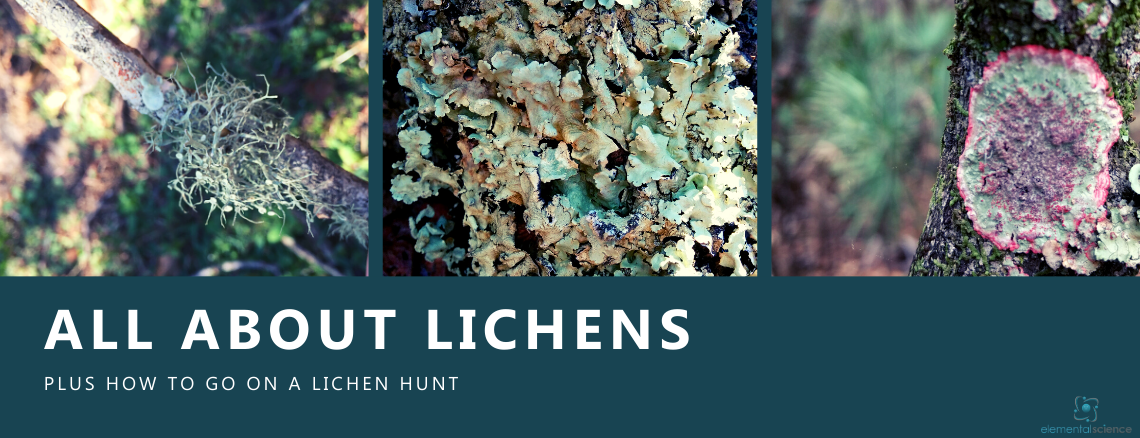FREE Shipping on all our products! (Please Note: Orders may experience a delay of a week or more in shipping due to the high volume of orders at this time of year.)
FREE Shipping on all our products! (Please Note: Orders may experience a delay of a week or more in shipping due to the high volume of orders at this time of year.)
How to hunt up the perfect winter nature study subject . . . lichens! {Plus a free notebooking page}
November 09, 2020 3 min read

Lichens are perfect to study in the fall and winter. As the trees are shedding their leaves and the plants are starting to die off, the lichens in the area begin to stand out.
Plus, lichens can be found all over the world, including in the desert!
Typically, you will find lichens on the bark of a tree or on a rock. Many lichens are about the size of a human fist, but they can grow to be as large as dinner plates and even larger.
As you study lichens using the information and activity below, you can download the following notebooking page to document it all:
Let’s take a closer look at the amazing lichen!
What are lichens?

Lichens are the result of a symbiotic, or mutually beneficial, partnership between a fungus and an alga plant or a bacterium. In other words, they are technically not plants, but rather a living partnership.
In the lichen partnership, the fungi protect the algae or bacteria that live below. In turn, the algae or bacteria provide the fungi with the sugars they need to grow.
Lichens reproduce using diaspores, which are released into the air. The diaspore is simply a spore with some additional tissue. Lichen diaspores contain spores from the fungus plus a few cells from the alga or bacterium. Once the diaspora lands in a suitable place, it grows and develops into another lichen.
As I said before lichens are found through the world, growing on tree trunks and rocks. Lichens can be found in some of the harshest environments, such as the Arctic tundra.
3 Types of Lichens
There are three main types of lichens:
- Fruticose – These lichens are shrub-like. (pictured above on the left)
- Foliose – These lichens are more leaf-like. (pictured above in the center)
- Crustose – These lichens are flat and crusty. (pictured above on the right)
The crustose lichen is generally the most recognized type. But the three different types of lichens can all be found in most environments.
How to go on a Lichen Hunt
So now that your students understand a bit more about the amazing lichen, it is time to take them on a lichen hunt!
What you need
You will need:
- a magnifying glass
- a putty knife
What to do
Begin by taking the students for a walk around your house or in your local woods to look for examples of lichens on trees and rocks.
After they find a lichen, ask them these questions to help their observations:
- Where do the lichens grow (i.e. full sun, partial shade, or dark)?
- What do the lichens grow on (i.e. rocks, ground, or glass)?
- What type of lichens did you find?
Have the students observe the lichen with their magnifying glass to see how it is different or it is similar to other plants they have observed.
Once they have looked at the lichen up close, scrape off a tiny bit of the lichen with the putty knife. Have the students turn it over and examine the underside of the sample.
If possible, have the students look for all three types of lichens. Have them observe each one in the same way, noting any similarities and/or differences.
Wrapping it Up
Lichens are the result of an amazing biological partnership. They are a fascinating living example of symbiosis, perfect for a fall study.
If you want to learn more about plant life, check out the following:
Also in Homeschool Science Activities
Don’t Be Afraid To Try These 3 Christmas Tree Experiments Right Now
December 07, 2024 3 min read

It's the most wonderful time of the year and these three Christmas tree experiments will make your season even brighter! Click "Read More" to see them.
Steps For Dissecting A Seed By Felipe Moreno
November 09, 2024 2 min read

Felipe Moreno, one of the Sassafras twins' botany experts, shares an Argentinian folk ballad which shares the steps for dissecting a seed.
How to make a Beautiful Fall Leaf Book {A Fall Science Activity}
September 21, 2024 2 min read

Want to preserve the beauty of fall for science? Click "Read More" to learn how to make a fall leaf book and download the free templates!
Subscribe
Sign up to get the latest on sales, new releases and more …

